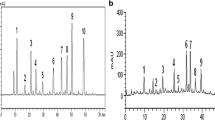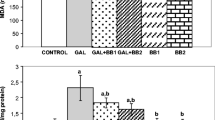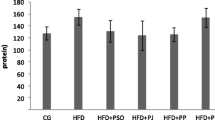Abstract
The pharmacological significance of acha (Digitaria exilis) and black cumin (Nigella sativa) in fostering sound mental health has been demonstrated in several researches. The current study looked at the effects of black cumin-enriched acha-based cookies on antioxidant and cholinesterases [acetylcholinesterase (AChE) and butyrylcholinesterase (BChE)] activities in the brain of high-fat/streptozotocin-induced type-2 diabetic mice infected with Plasmodium bergei. The mice were infected with Plasmodium berghei (NK65 strain) after receiving STZ (50 mg/kg b.w.) intraperitoneally to cause diabetes and high blood glucose levels of > 200 mg/dL. Then, as a treatment, the acha-based cookies enriched with black cumin were administered to the experimental mice. The effect of the cookies on neuronal cholinesterases (AChE and BChE) activities, reactive oxygen species (ROS), thiobarbituric acid reactive species (TBARS), and reduced glutathione (GSH) levels, as well as neuronal antioxidant [superoxide dismutase (SOD), catalase, glutathione-s-transferase (GST), and glutathione peroxidase (GPx)] were assessed. The outcome revealed a (P < 0.05) rise in cholinesterases and MAO activities, ROS, and TBARS levels, with a concomitant decrease in neuronal antioxidant enzymes and GSH levels in the P. bergei-infected diabetic mice. However, the consumption of black cumin-enriched acha-based cookies by the mice caused an improved antioxidant status and significantly decreased the activities of AChE, BChE, and MAO activities and ROS and TBARS levels. The neuroprotective potential of the cookies, in particular, in the treatment of neurochemical deficit in P. bergei-infected diabetic mice was confirmed.





Similar content being viewed by others
Data availability
No datasets were generated or analyzed during the current study.
References
Adedayo BC, Ajiboye OM, Oyeleye IS, Ojo RO, Oboh G. Effect of alkaloid extract from Andrographis paniculata (Burm. f.) Nees and Phyllanthus amarus Schumach. & Thonn. on cognitive-related biochemicals in the brain of streptozotocin-induced diabetic rats. Pharmacol Res-Modern Chinese Med. 2023;9:100314.
Strachan MW, Price JF, Frier BM. Diabetes, cognitive impairment, and dementia. BMJ. 2008;336:6.
Cole AR, Astell A, Green C, et al. Molecular connexions between dementia and diabetes. Neurosci Biobehav Rev. 2007;31:1046–63.
Grunblatt E, Bartl J, Riederer P. The link between iron, metabolic syndrome, and Alzheimer’s disease. J Neural Transm. 2011;118:371–9.
Reimann M, Bonifacio E, Solimena M, Schwarz PE, Ludwig B, Hanefeld M, Bornstein SR. An update on preventive and regenerative therapies in diabetes mellitus. Pharmacol Ther. 2009;121:317–31.
Maiara N, Rodrigo J, Beatriz A, Ana Maria G, Hugo C, Tatiana M. Neurovascular interactions in Malaria. NeuroImmunoModulation. 2021;28(3):108–17.
Sanjay K, Deepak K, Rajiv S, Sameer A, Deep D. Malaria and diabetes. J Pak Med Assoc. 2017;5:810–3.
Takruri HR, Dameh MA. Study of the nutritional value of black cumin seeds (Nigella sativa L). J Sci Food Agric. 1998;76:404–10.
Ramadan MF. Nutritional value, functional properties and nutraceutical applications of black cumin (Nigella sativa L.): an overview. Int J Food Sci Technol. 2007;42:1208–18.
Javed S, Shahid AA, Haider MS. Nutritional, phytochemical potential and pharmacological evaluation of Nigella Sativa (Kalonji) and Trachyspermum Ammi (Ajwain). J Med Plant Res. 2010;6:768–75.
Ahmad I, Tripathi J, Manik S, Umar L, Rabia J. Preliminary phytochemical studies of the miracle herb of the century, Nigella sativa L. (black seed). IAJPS. 2013;3:3000–7.
Bukhari AA. Why black seed can be the cure for all illnesses except death. Advancement in Med Plant Res. 2018;9:75–80.
Farkhondeh T, Samarghandian S, Borji A. An overview on cardioprotective and anti-diabetic effects of thymoquinone. Asian Pac J Trop Med. 2017;10:849–54.
Khader M, Eckl PM. Thymoquinone: an emerging natural drug with a wide range of medical applications. Iran J Basic Med Sci. 2014;17:950–7.
Jideani IA. Traditional and possible technological uses of Digitaria exilis (Fonio) and Digitaria iburua (iburu): a review. Plant Foods Hum Nutr. 1999;54:363–74.
Gyang JD, Wuyep EO. Acha: the grain of life. A bi-annual Public Raw Mater Res Dev Coun. 2005;6(1):39–41.
Jideani VA, Podgorski SC. In vitro starch digestibility and glycemic property of acha (Digitaria exilis) porridge. Cereal Foods World Suppl. 2009;54:48.
Gbenga-Fabusiwa FJ, Oladele EP, Oboh G, Adefegha SA, Oshodi AA. Nutritional properties, sensory qualities and glycemic response of biscuits produced from pigeon pea-wheat composite flour. J Food Biochem. 2018;42(4): e12505.
Oguntuase SO, Fasakin OW, Oyeleye SI, Oboh G. Effects of dietary inclusion of Bambara groundnut and sweet orange peels on streptozotocin/HFD type-2 induced diabetes mellitus complications and related biochemical parameters. J of Food Biochem. 2022;46(11): e14373.
Wang X, Long D, Hu X, Guo N. Gentiopicroside modulates glucose homeostasis in high-fat-diet and streptozotocin-induced type 2 diabetic mice. Frontiers Pharmacol. 2023;14. https://doi.org/10.3389/fphar.2023.1172360
Ojueromi OO, Oboh G, Ademosun AO. Effect of black seeds (Nigella sativa) on inflammatory and immunomodulatory markers in Plasmodium berghei-infected mice. J Food Biochem. 2022;46(11): e14300.
Belle NA, Dalmolin GD, Fonini G, Rubim MA, Rocha JB. Polyamines reduces lipid peroxidation induced by different prooxidant agents. Brain Res. 2004;1008:245–51.
Adefegha SA, Oboh G, Dada FA, Okeke BM, Oyeleye SI. Berberine mitigates diabetes-induced erectile dysfunction in rats through modulation of antioxidant status and critical enzyme activity. Comp Clin Pathol. 2021;30:181–9.
Oyeleye IS, Ogunsuyi OB, Oluokun OO, Oboh G. Seeds of moringa (Moringa oleifera) and mucuna (Mucuna pruriens L.) modulate biochemical indices of L-NAME-induced hypertension in rats: a comparative study. J Agricul Food Res. 2023;12:100624.
Oyeleye IS, Ojo OR, Oboh G. Effect of formulated polyherbal tea blends on erectile function biomarkers in streptozotocin (STZ)-induced diabetic Male Rats. Food Chem Advances. 2023;2: 100237.
Olasehinde TA, Akomolafe SF, Oladapo IF, Oyeleye SI. Effect of diet supplemented with African star apple fruit pulp on purinergic, cholinergic and monoaminergic enzymes, TNF-α expression and redox imbalance in the brain of hypertensive rats. Nutr Neurosci. 2023;26(496):510.
Jewett SL, Rocklin AM. Variation of one unit of activity with oxidation rate of organic substrate in indirect superoxide dismutase assays. Anal Biochem. 1993;212(2):555–9.
Sinha AK. Colorimetric assay of catalase. Anal Biochem. 1972;47(2):389–94.
Akinyemi AJ, Oboh G, Ademiluyi AO, Araoye OO, Oyeleye SI. Dietary inclusion of local salt substitutes induces oxidative stress and renal dysfunction in rats. Rev Environ Health. 2014;29:355–61.
Ellman GL. Determination of sulfhydryl group. Arch Biochem Biophys. 1959;82:70–4.
Habig WH, Jakoby WB. Assays for differentiation of glutathione S-transferases. In Methods in enzymology. 1981;77:398–405.
Taylor P, Radić Z. The cholinesterases: from genes to proteins. Annu Rev Pharmacol Toxicol. 1994;34:281–320.
Ballard CG, Greig NH, Guillozet-Bongaarts AL, Enz A, Darvesh S. Cholinesterases: roles in the brain during health and disease. Curr Alzheimer Res. 2005;2:307–18.
Jung M, Park M. Acetylcholinesterase inhibition by flavonoids from Agrimonia pilosa. Molecules. 2007;12:2130–9.
Salma A, El-Marasy, Siham M, El-Shenawy, Aiman S, El-Khatib, Osama A, El-Shabrawy, Sanaa A, Kenawy (2012) Effect of Nigella sativa and wheat germ oils on scopolamine-induced memory impairment in rats. Bull Fac Pharm 81–88.
Basant M, Morsy, Ghada MS, Doaa AH, Reem MS. The protective effect of Nigella sativa oil extract against neurotoxicity induced by Valproic acid. Int J Bioassays. 2017;6(9):5474–5484.
Riederer P. Monoamine oxidase-B inhibition in Alzheimer’s disease. Neurotoxicology. 2004;25:271–7.
Riederer P, Sofic E, Rausch WD, et al. Transition metals, ferritin, glutathione, and ascorbic acid in parkinsonian brains. J Neurochem. 1989;52:515–20.
Tahereh F, Saeed S, Ali M, Pourbagher S, Fariborz S. The neuroprotective effects of thymoquinone: a review. Dose Response. 2018;16(2):1559325818761455.
Oyeleye SI, Olasehinde TA, Fasakin OW, Oboh G, Saliu JAJ. Phyllanthus amarus Schumach. & Thonn. and Momordica charantia L extracts improve memory function, attenuate cholinergic and purinergic dysfunction, and suppress oxidative stress in the brain of doxorubicin–treated rats. Phytomedicine Plus. 2022;2(2):100283.
Cynthia A, Massaad EK. Reactive oxygen species in the regulation of synaptic plasticity and memory. ARS. 2011;14(10):2013–54. https://doi.org/10.1089/ars.2010.3208.
Kazemi M. Phytochemical composition, antioxidant, anti-inflammatory and antimicrobial activity of Nigella sativa L. essential oil. J Essent Oil Bear Plants. 2014;17:1002–11.
Schimke I, Kahl PE, Romaniuk P, Papies B. Concentration of thiobarbituric acid reactive substances (TBARS) in serum following myocardial infarct. Klin Wochenschr. 1986;64(23):1237–9. https://doi.org/10.1007/bf01734466.
Oyeleye SI, Ademiluyi AO, Raymond OO, Oboh G. Synergistic cardioprotective ability of co-administration of Moringa supplemented diets and acarbose in diabetic cardiomyopathy involves attenuation of cholinergic, purinergic, monoaminergic, renin-angiotensin system, and antioxidant pathways. J Food Biochem. 2022;46: e14475.
Islam MT. Oxidative stress and mitochondrial dysfunction-linked neurodegenerative disorders. Neurological Res. 2017;39:73–82.
Brigelius-Flohe R. Tissue-specific functions of individual glutathione peroxidases. Free Radic Biol Med. 1999;27:951–65.
Author information
Authors and Affiliations
Contributions
OG, OB, OI, NE, and OO designed the manuscript. OB, OI, and OO are involved in data acquisition and interpretation of data. OB, OI, and OO prepared the figures. OB was involved in the initial draft of the manuscript. OB and OI corrected the manuscript. All authors reviewed the manuscript.
Corresponding author
Ethics declarations
Ethics approval
The animals were handled according to the guidelines of the Ethical Committee of the Federal University of Technology, Akure, Nigeria (FUT/SOS/1411).
Competing interests
The authors declare no competing interests.
Recommendation
We recommend that the cookies should be subjected to clinical observation study.
Rights and permissions
Springer Nature or its licensor (e.g. a society or other partner) holds exclusive rights to this article under a publishing agreement with the author(s) or other rightsholder(s); author self-archiving of the accepted manuscript version of this article is solely governed by the terms of such publishing agreement and applicable law.
About this article
Cite this article
Nwanna, E., Olanrewaju, B., Oyeleye, I.S. et al. Effect of black cumin-enriched acha-based cookies on antioxidant status and cholinergic enzymes in the brain of Plasmodium berghei-infected diabetic mice. Nutrire 49, 18 (2024). https://doi.org/10.1186/s41110-024-00260-z
Received:
Accepted:
Published:
DOI: https://doi.org/10.1186/s41110-024-00260-z




